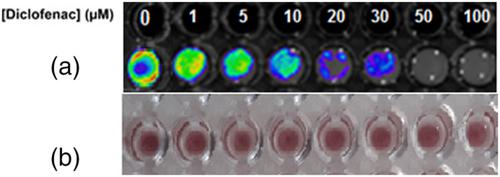当前位置:
X-MOL 学术
›
Luminescence
›
论文详情
Our official English website, www.x-mol.net, welcomes your
feedback! (Note: you will need to create a separate account there.)
Selective inhibition of Zophobas morio (Coleoptera: Tenebrionidae) luciferase‐like enzyme luminescence by diclofenac and potential suitability for light‐off biosensing
Luminescence ( IF 3.2 ) Pub Date : 2020-09-22 , DOI: 10.1002/bio.3952 Mariele C Carvalho 1 , Atílio Tomazini 2 , Rogilene A Prado 3 , Vadim R Viviani 1, 3
Luminescence ( IF 3.2 ) Pub Date : 2020-09-22 , DOI: 10.1002/bio.3952 Mariele C Carvalho 1 , Atílio Tomazini 2 , Rogilene A Prado 3 , Vadim R Viviani 1, 3
Affiliation

|
The accumulation of toxic carboxylic compounds may cause severe effects on the environment and living organisms. A luciferase‐like enzyme, previously cloned from the Malpighian tubules of the non‐luminescent Zophobas morio mealworm, displays thioesterification activity with a wide range of carboxylic substrates, and produces weak red luminescence in the presence of ATP and firefly d‐luciferin, a xenobiotic for this organism. To better investigate the function of this enzyme in carboxylic xenobiotic detoxification, we analyzed the inhibitory effect of different xenobiotic carboxylic acids on the luminescence activity of this enzyme, including environmental pollutants and pharmaceutical compounds. Noteworthy, the anti‐inflammatory drug diclofenac severely inhibited this luciferase‐like enzyme luminescence activity, both in in vitro (IC50 20 μM) and in vivo in bacterial cells assays, when compared with other beetle luciferases. Similar results were obtained with its brighter I327S mutant. Kinetic analysis of diclofenac's effect on luminescence activity indicated mixed‐type inhibition for both ATP and d‐luciferin. Modelling studies showed five potential binding sites for diclofenac, including the coenzyme A binding site, which showed one of the highest binding constant. Taken together, these results raise the possibility of using this luciferase‐like enzyme for the development of novel whole‐cell luminescent biosensors for diclofenac and similar drugs.
中文翻译:

双氯芬酸选择性抑制Zophobas morio(Coleoptera:Tenebrionidae)萤光素酶样酶的发光及其潜在的适用于起步生物传感的可能性
有毒的羧酸化合物的积累可能对环境和生物造成严重影响。荧光素酶样酶,从先前的非发光的马氏管克隆Zophobas森尾黄粉虫,显示与广泛的羧酸底物的硫酯化活性,在ATP和萤火虫的存在产生的红色发光弱d荧光素,一种针对这种生物的异种生物。为了更好地研究这种酶在羧酸异种生物排毒中的功能,我们分析了不同异种生物羧酸对这种酶的发光活性的抑制作用,包括环境污染物和药物化合物。值得注意的是,与其他甲虫萤光素酶相比,抗炎药双氯芬酸在体外(IC 50 20μM)和体内细菌细胞测定中均会严重抑制这种萤光素酶样酶的发光活性。其更亮的I327S突变体获得了相似的结果。动力学分析双氯芬酸对发光活性的影响表明对ATP和d的混合型抑制荧光素。建模研究显示了双氯芬酸的五个潜在结合位点,包括辅酶A结合位点,后者显示出最高的结合常数之一。综上所述,这些结果增加了使用这种萤光素酶样酶开发双氯芬酸和类似药物的新型全细胞发光生物传感器的可能性。
更新日期:2020-09-22
中文翻译:

双氯芬酸选择性抑制Zophobas morio(Coleoptera:Tenebrionidae)萤光素酶样酶的发光及其潜在的适用于起步生物传感的可能性
有毒的羧酸化合物的积累可能对环境和生物造成严重影响。荧光素酶样酶,从先前的非发光的马氏管克隆Zophobas森尾黄粉虫,显示与广泛的羧酸底物的硫酯化活性,在ATP和萤火虫的存在产生的红色发光弱d荧光素,一种针对这种生物的异种生物。为了更好地研究这种酶在羧酸异种生物排毒中的功能,我们分析了不同异种生物羧酸对这种酶的发光活性的抑制作用,包括环境污染物和药物化合物。值得注意的是,与其他甲虫萤光素酶相比,抗炎药双氯芬酸在体外(IC 50 20μM)和体内细菌细胞测定中均会严重抑制这种萤光素酶样酶的发光活性。其更亮的I327S突变体获得了相似的结果。动力学分析双氯芬酸对发光活性的影响表明对ATP和d的混合型抑制荧光素。建模研究显示了双氯芬酸的五个潜在结合位点,包括辅酶A结合位点,后者显示出最高的结合常数之一。综上所述,这些结果增加了使用这种萤光素酶样酶开发双氯芬酸和类似药物的新型全细胞发光生物传感器的可能性。











































 京公网安备 11010802027423号
京公网安备 11010802027423号